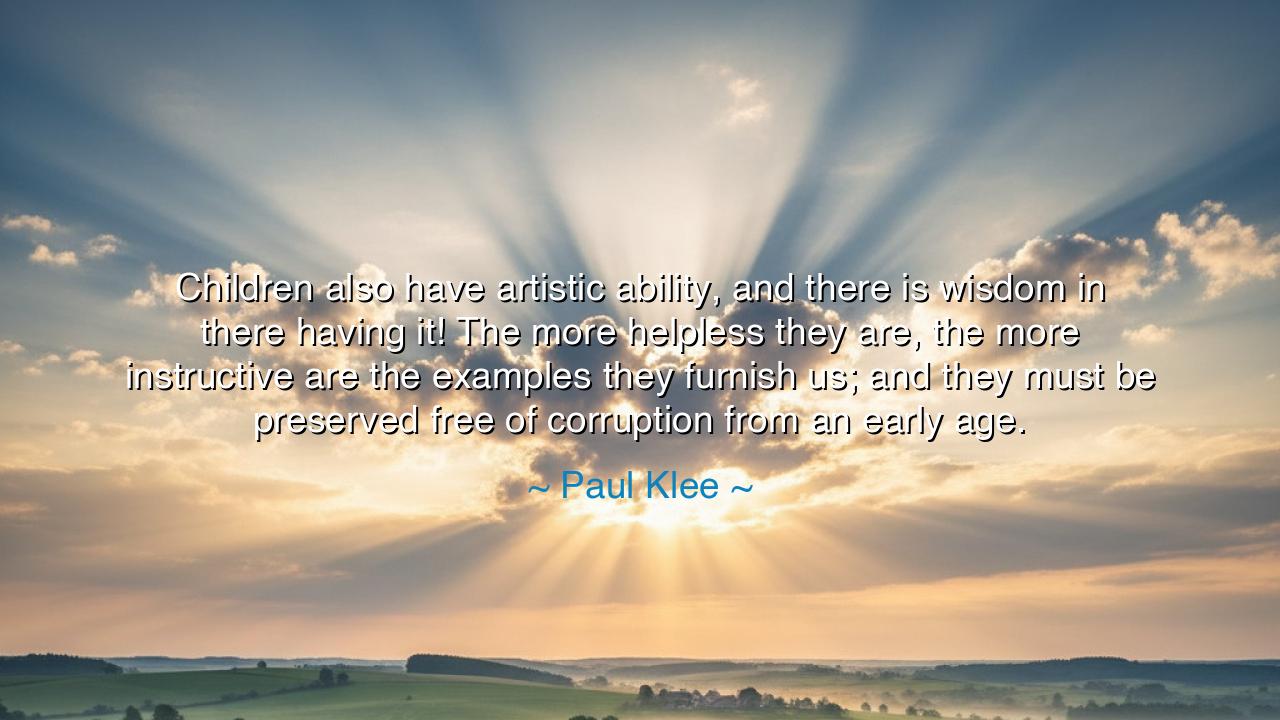
Children also have artistic ability, and there is wisdom in there
Children also have artistic ability, and there is wisdom in there having it! The more helpless they are, the more instructive are the examples they furnish us; and they must be preserved free of corruption from an early age.






Children also have artistic ability, said Paul Klee, and in those few words lies a truth as ancient as the dawn of humankind. For the child is not yet bound by the rigid frames of reason or the heavy armor of habit; the child sees with unclouded eyes, as the first humans once did when they looked upon the sun and called it divine. Their artistic ability springs not from training but from instinct, from that original spark that whispers, "All things are alive, and I am part of them." In the fragile hands of a child lies the memory of the universe before it was divided into science and art, knowledge and feeling. Thus, Klee’s words are not mere praise of youth, but a sacred warning: do not extinguish the light that burns in the young before it has had the chance to illuminate the world.
In the helplessness of children, there is a mirror held up to our own beginnings. Their innocence is not weakness but instruction. For in their stumbles, they teach us patience; in their laughter, they reveal joy unburdened by possession; in their art—those crude lines and bold colors—they reveal what we adults have forgotten: that creation is not perfection, but the freedom to express what the soul feels. The helpless child is, paradoxically, the greatest teacher, for in their dependence, they awaken our compassion, and in their play, they remind us of what it means to be alive without pretense.
Consider the story of the painter Henri Rousseau, a man mocked for his naïve style. He had never studied in any academy, and yet, his art carried a wonder that professional artists could not replicate. His paintings of jungles, born from imagination and childlike awe rather than observation, spoke to something ancient and pure. Critics laughed at him, but Picasso, that mighty prophet of the modern brush, once threw a feast in Rousseau’s honor, declaring him a true artist of the spirit. Rousseau, like a child, painted not what he saw, but what he felt—and in doing so, he preserved the wisdom Klee spoke of: that the uncorrupted heart can reveal truths the learned mind no longer perceives.
The corruption of which Klee warns is subtle. It enters not through malice but through conformity. It whispers, “Color within the lines,” and so we do. It says, “Draw what you see, not what you dream,” and so we forget the dream. As we grow, the world rewards precision and punishes wonder, until we no longer ask “why?” but only “how?” Thus, the freedom of creation—the very pulse of art—is chained by the illusion of correctness. The child paints the sun green and the sky red; the adult corrects them, and in that correction, a small star of imagination dies.
To preserve the child “free of corruption from an early age” is to protect that divine spark before it is buried under layers of imitation. It does not mean sheltering them from knowledge, but rather, guiding them with reverence, so that knowledge becomes a tool of imagination, not its cage. The ancient Greeks understood this balance; their philosophers and poets were not separate but one, for they believed wisdom and art to be siblings born of the same mother—Truth. The sculptor who shaped marble into gods was no less a philosopher than Socrates, for both sought to uncover what lay beyond appearances.
There is a lesson here for all who live in this age of noise and speed. We must learn again from the children, as they once learned from us. When a child asks a question, answer not only with fact but with wonder. When they draw, do not judge the lines, but ask what story they tell. Let your own hands return, from time to time, to clay, to paint, to music. For art is not a craft alone—it is a remembrance of the eternal play between soul and creation.
So I say to you, as the ancients would: guard the flame of youth, both in the young and within yourself. Do not let cynicism quench it, nor the weariness of years bury it beneath reason. For the artistic ability of the child is not theirs alone—it is the seed of all human greatness. In every heart still beats a small, untamed child, waiting to create, to sing, to dance without fear. Let that child live, and in doing so, you will rediscover not only art but wisdom itself.
Practical teaching: Each day, seek one act of creation unmeasured by judgment—draw, write, build, sing, or dream. Protect the wonder in children as you would guard sacred fire. And when you behold their helplessness, do not see frailty; see instruction—a reminder that the purest wisdom is born from humility, and the greatest art begins not in mastery, but in innocence.






AAdministratorAdministrator
Welcome, honored guests. Please leave a comment, we will respond soon